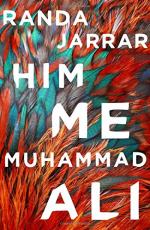|
This section contains 772 words (approx. 2 pages at 400 words per page) |

|
Him, Me, Muhammad Ali Summary & Study Guide Description
Him, Me, Muhammad Ali Summary & Study Guide includes comprehensive information and analysis to help you understand the book. This study guide contains the following sections:
This detailed literature summary also contains Quotes and a Free Quiz on Him, Me, Muhammad Ali by Jarrar, Randa.
The following version of this book was used to create the guide: Jarrar, Randa. Him, Me, Muhammad Ali. Sarabande, 2016.
Jarrar begins her book with the short story “Lunatics’ Eclipse.” The main characters, Qamar and Hilal, are obsessed with the moon and do outlandish things for it, such as trying to catch it with a rope, in order for their dreams of love to come true. For Qamar her heart closes when her dream of marriage is spoiled, her parents have a premature death, and she must face an unwanted arranged marriage. When she meets Hilal, she meets a fellow moon-worshipper and also a man with a broken heart. At the end of the story, they quit their fantasies and try reality with each other. In “Building Girls,” the woman protagonist, Aisha, is afraid to be vulnerable in any relationship after her failed and violent marriage. Her childhood friend, Perihan, returns, and they have an intimate relationship. However, Perihan is distant, and they are left with a communication challenge no one can cross. In “Lost in Freakin’ Yonkers” a brash 18-year-old young woman is pregnant and disowned from her immigrant Arab family. Her boyfriend James is a drunk. Her sarcastic humor breaks at end of the story when, after backing up into another vehicle, she tells her sob story to a police office and they let her go. “How Can I Be of Use to You” is a story with fallen idols and hypocrisy. The narrator works in an unpaid assistant ship with a well-known Egyptian feminist writer named Mansoura. Ironically, the female narrator is treated poorly, as Mansoura habitually likes things her way. The narrator, in a stasis of whether to leave the job, finally realizes she is Mansoura’s audience and little else, then leaves.
The short story “A Sailor” opens with a wife confessing to her husband that she slept with a Turkish sailor. The husband is not upset. She then starts an argument wondering why he is not upset. The husband stands his calm ground while the wife realizes she remains with him because of his dispassionate and calm demeanor.
“Grace” is a story of a young girl who is kidnapped and brought to a commune. She feels as if she belongs in this new place and eventually does not miss her family, not even her little sister, Ida. Years later, she looks up Ida on the Internet and finds she is a writer. Ida had written a book about Grace’s kidnapping and commune life without contacting her. Grace senses they are even now and does not reach out to her. “Testimony of Malik, Prisoner #287690” details a kestrel taken into custody and interrogated by the Turkish anti-terrorism unit. Because the falcon has an Israeli migration tag on its ankle, he is believed to be a spy. After x-rays and the relaying his sad story of a lonely life, including disownment from his family, the loss of his mother, and constant wanderings for home, the commanders release him. “Accidental Transients” is a story of independence. Dina, the eldest and only daughter in and Arab family, must do the cooking and cleaning for her father and brothers, and they harass for this. She eventually gets the courage to leave. In “Asmahan” an affluent family accidentally hits a poor girl with their car. They take her to the hospital, bestow gifts upon her, and through conversation and presence, the two economic classes of characters earn each other’s respect.
In “Him, Me and Muhammad Ali”, a young woman, Kinshasa, finds healing from her emotional wounds as she searches for the proper place to spread her father’s ashes. The father wanted his ashes spread at a pyramid in Egypt. Finding the pyramids offensive to her father’s memory, Kinshasa takes the ashes back to White Plains, New York and buries them in the backyard of their house. “The Story of My Building” is a coming of age story where a ten-year old boy releases his naiveté and opens his eyes to the devastation of his neighborhood when his house is reduced to rubble by the Israeli forces. In “A Frame for the Sky” the narrator recounts his life though his worst days. His atonement is understanding his life as a framework and foundation that his son will build upon. “The Life, Loves, and Adventures of Zelwa the Halfie” is a story about a half-human and half-goat who faces discrimination and ridicule for her appearance. She decides the most courageous act is to work daily on her self-acceptance and refuses a surgery that would make her a whole
Read more from the Study Guide
|
This section contains 772 words (approx. 2 pages at 400 words per page) |

|



